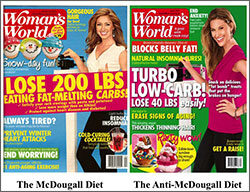Simple Reasoning Solves Dietary Confusion
 Daily, I am asked to justify my recommendations for a starch- (corn-, potato-, rice-) based diet over other diets that offer contrary advice. (Below is a concise review of the McDougall Plan). The effects of different diets are far too complex to make meaningful such side-by-side comparisons. I would like to, however, share with you some of my past professional educational opportunities in order for you to better understand how my views developed over 40 years ago. Using the “Search” feature on my website (www.drmcdougall.com) will also help you find many articles about the specific concerns I have for other popular diets you may have been considering. (Enter terms such as: low-carb diet, low-fat diet, Grain Brain, Wheat Belly, Atkins, lectin-free, nutrient dense diet, vegan diet, and vegetarian diet.)
Daily, I am asked to justify my recommendations for a starch- (corn-, potato-, rice-) based diet over other diets that offer contrary advice. (Below is a concise review of the McDougall Plan). The effects of different diets are far too complex to make meaningful such side-by-side comparisons. I would like to, however, share with you some of my past professional educational opportunities in order for you to better understand how my views developed over 40 years ago. Using the “Search” feature on my website (www.drmcdougall.com) will also help you find many articles about the specific concerns I have for other popular diets you may have been considering. (Enter terms such as: low-carb diet, low-fat diet, Grain Brain, Wheat Belly, Atkins, lectin-free, nutrient dense diet, vegan diet, and vegetarian diet.)
I understand if you are frustrated and unsure about who is telling the truth. We in the United States, and many other parts of the world, live under what is called freedom—freedom of speech, choice, and trade. Unfortunately, this luxury often translates into unregulated business practices by the food (and all other) industries. Even when I believe that I hold the truth, and even when I find that my diet-therapy results are consistently successful with my patients, the meat, dairy, egg, fish, and other food industries usually win “the information game” because they have millions of dollars to push their products using television, newspapers, books, radio, and online. The saying, “all is fair in love and in war” applies even when the casualties are consumers and their families, with consequences being as extreme as loss of life.
Recommended Articles

McDougall Mastermind: Protein

The Ultimate Diabetic Diet Plan: How to Manage Blood Sugar Through Nutrition





